GTA San Andreas theme by Snowlegend
Download: GTASanAndreas.p3t
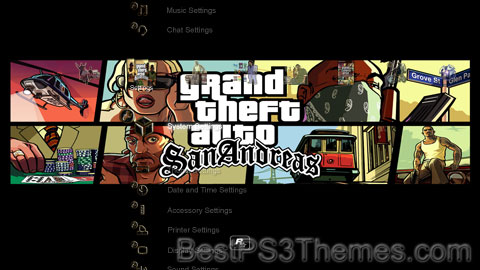
(2 backgrounds)
Redirect to:
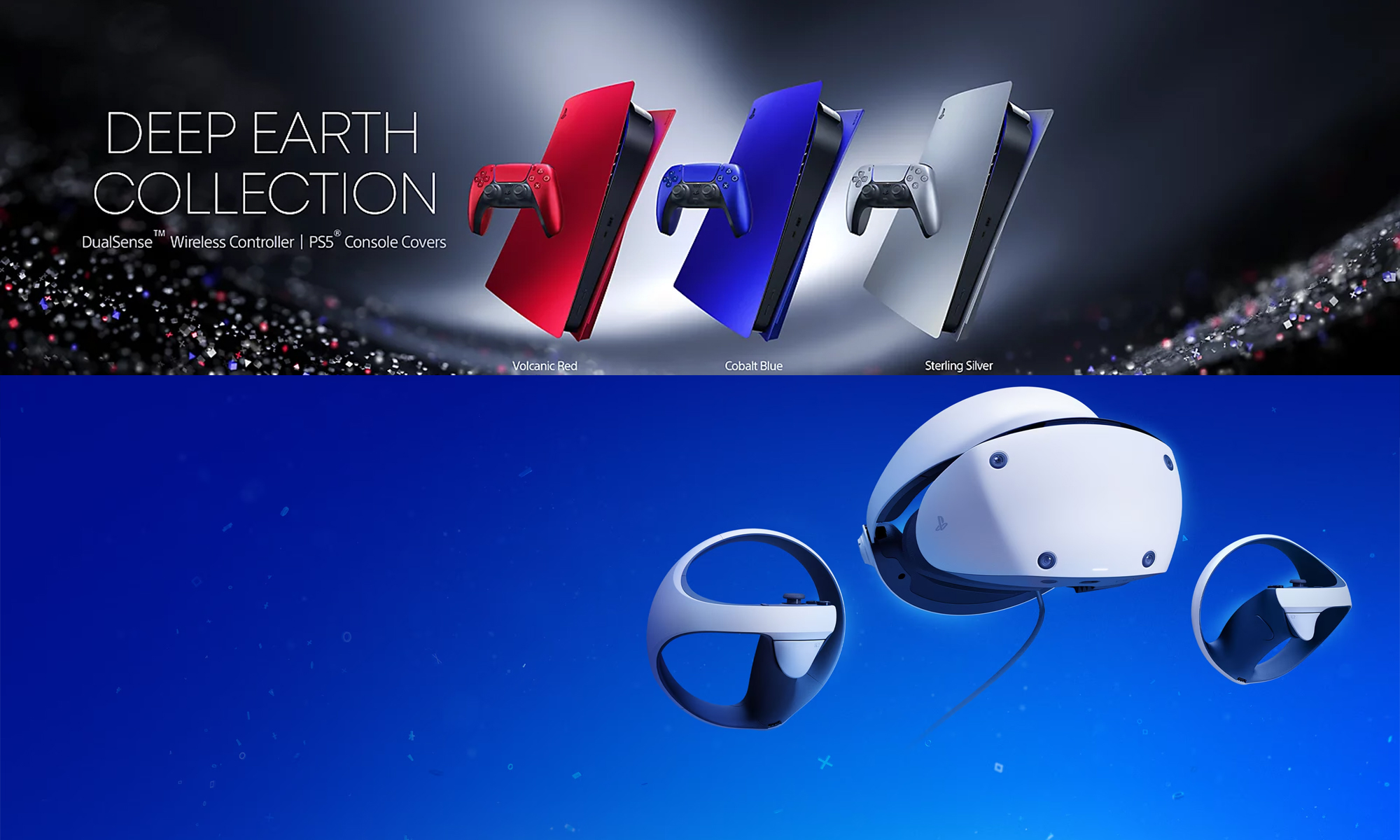
The #1 spot for Playstation themes!
FIFA 09 Carlisle Utd theme by Dave Robinson
Download: FIFA09CarlisleUtd.p3t
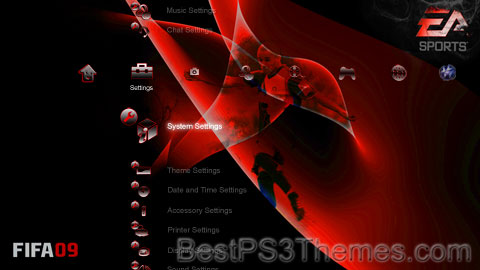
(3 backgrounds)
P3T Unpacker v0.12
Copyright (c) 2007. Anoop Menon
This program unpacks Playstation 3 Theme files (.p3t) so that you can touch-up an existing theme to your likings or use a certain wallpaper from it (as many themes have multiple). But remember, if you use content from another theme and release it, be sure to give credit!
Download for Windows: p3textractor.zip
Instructions:
Download p3textractor.zip from above. Extract the files to a folder with a program such as WinZip or WinRAR. Now there are multiple ways to extract the theme.
The first way is to simply open the p3t file with p3textractor.exe. If you don’t know how to do this, right click the p3t file and select Open With. Alternatively, open the p3t file and it will ask you to select a program to open with. Click Browse and find p3textractor.exe from where you previously extracted it to. It will open CMD and extract the theme to extracted.[filename]. After that, all you need to do for any future p3t files is open them and it will extract.
The second way is very simple. Just drag the p3t file to p3textractor.exe. It will open CMD and extract the theme to extracted.[filename].
For the third way, first put the p3t file you want to extract into the same folder as p3textractor.exe. Open CMD and browse to the folder with p3extractor.exe. Enter the following:
p3textractor filename.p3t [destination path]Replace filename with the name of the p3t file, and replace [destination path] with the name of the folder you want the files to be extracted to. A destination path is not required. By default it will extract to extracted.filename.
Pixar theme by Snowlegend
Download: Pixar_2.p3t
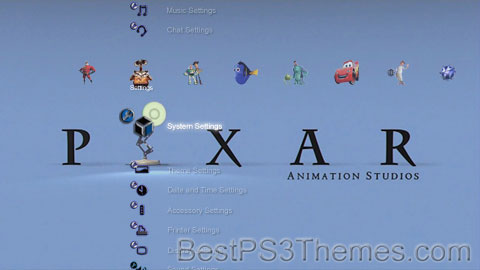
(8 backgrounds)
Logo used since 1995 | |
 Headquarters in Emeryville, California | |
| Company type | Subsidiary |
|---|---|
| Industry | Animation |
| Predecessor | The Graphics Group of Lucasfilm Computer Division (1979–1986) |
| Founded | February 3, 1986 in Richmond, California |
| Founders | |
| Headquarters | 1200 Park Avenue, , U.S. |
Area served | Worldwide |
Key people |
|
| Products | Computer animations |
| Brands | |
Number of employees | 1,233 (2020) |
| Parent | Walt Disney Studios (2006–present) |
| Website | www |
| Footnotes / references [1][2][3] | |
Pixar Animation Studios, known simply as Pixar (/ˈpɪksɑːr/), is an American animation studio based in Emeryville, California, known for its critically and commercially successful computer-animated feature films. Since 2006, Pixar has been a subsidiary of Walt Disney Studios, a division of Disney Entertainment, a segment of the Walt Disney Company.
Pixar started in 1979 as part of the Lucasfilm computer division. It was known as the Graphics Group before its spin-off as a corporation in 1986, with funding from Apple co-founder Steve Jobs who became its majority shareholder.[2] Disney announced its acquisition of Pixar in January 2006, and completed it in May 2006.[4][5][6] Pixar is best known for its feature films, technologically powered by RenderMan, the company's own implementation of the industry-standard RenderMan Interface Specification image-rendering API. The studio's mascot is Luxo Jr., a desk lamp from the studio's 1986 short film of the same name.
Pixar has produced 28 feature films, starting with Toy Story (1995), which is the first fully computer-animated feature film; its most recent film was Inside Out 2 (2024). The studio has also produced many short films. As of July 2023[update], its feature films have earned over $15 billion at the worldwide box office with an average gross of $546.9 million per film.[7] Toy Story 3 (2010), Finding Dory (2016), Incredibles 2 (2018), Toy Story 4 (2019) and Inside Out 2 (2024) all grossed over $1 billion and are among the 50 highest-grossing films of all time. Moreover, 15 of Pixar's films are in the 50 highest-grossing animated films of all time.
Pixar has earned 23 Academy Awards, 10 Golden Globe Awards, and 11 Grammy Awards, along with numerous other awards and acknowledgments. Since its inauguration in 2001, eleven Pixar films have won the Academy Award for Best Animated Feature, including Finding Nemo (2003), The Incredibles (2004), Ratatouille (2007), WALL-E (2008), Up (2009), the aforementioned Toy Story 3 and Toy Story 4, Brave (2012), Inside Out (2015), Coco (2017), and Soul (2020). Toy Story 3 and Up were also nominated for the Academy Award for Best Picture.
In February 2009, Pixar executives John Lasseter, Brad Bird, Pete Docter, Andrew Stanton, and Lee Unkrich were presented with the Golden Lion award for Lifetime Achievement by the Venice Film Festival. The physical award was ceremoniously handed to Lucasfilm's founder, George Lucas.
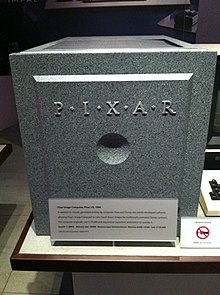
Pixar got its start in 1974, when New York Institute of Technology's (NYIT) founder, Alexander Schure, who was also the owner of a traditional animation studio, established the Computer Graphics Lab (CGL) and recruited computer scientists who shared his ambitions about creating the world's first computer-animated film. Edwin Catmull and Malcolm Blanchard were the first to be hired and were soon joined by Alvy Ray Smith and David DiFrancesco some months later, which were the four original members of the Computer Graphics Lab, located in a converted two-story garage acquired from the former Vanderbilt-Whitney estate.[8][9] Schure invested significant funds into the computer graphics lab, approximately $15 million, providing the resources the group needed but contributing to NYIT's financial difficulties.[10] Eventually, the group realized they needed to work in a real film studio to reach their goal. Francis Ford Coppola then invited Smith to his house for a three-day media conference, where Coppola and George Lucas shared their visions for the future of digital moviemaking.[11]
When Lucas approached them and offered them a job at his studio, six employees moved to Lucasfilm. During the following months, they gradually resigned from CGL, found temporary jobs for about a year to avoid making Schure suspicious, and joined the Graphics Group at Lucasfilm.[12][13] The Graphics Group, which was one-third of the Computer Division of Lucasfilm, was launched in 1979 with the hiring of Catmull from NYIT,[14] where he was in charge of the Computer Graphics Lab. He was then reunited with Smith, who also made the journey from NYIT to Lucasfilm, and was made the director of the Graphics Group. At NYIT, the researchers pioneered many of the CG foundation techniques — in particular, the invention of the alpha channel by Catmull and Smith.[15] Over the next several years, the CGL would produce a few frames of an experimental film called The Works. After moving to Lucasfilm, the team worked on creating the precursor to RenderMan, called REYES (for "renders everything you ever saw"), and developed several critical technologies for CG — including particle effects and various animation tools.[16]
John Lasseter was hired to the Lucasfilm team for a week in late 1983 with the title "interface designer"; he animated the short film The Adventures of André & Wally B.[17] In the next few years, a designer suggested naming a new digital compositing computer the "Picture Maker". Smith suggested that the laser-based device have a catchier name, and came up with "Pixer", which after a meeting was changed to "Pixar".[18] According to Michael Rubin, the author of Droidmaker: George Lucas and the Digital Revolution, Smith and three other employees came up with the name during a restaurant visit in 1981, but when interviewing them he got four different versions about the origin of the name.[19]
In 1982, the Pixar team began working on special-effects film sequences with Industrial Light & Magic. After years of research, and key milestones such as the Genesis Effect in Star Trek II: The Wrath of Khan and the Stained Glass Knight in Young Sherlock Holmes,[14] the group, which then numbered 40 individuals, was spun out as a corporation in February 1986 by Catmull and Smith. Among the 38 remaining employees were Malcolm Blanchard, David DiFrancesco, Ralph Guggenheim, and Bill Reeves, who had been part of the team since the days of NYIT. Tom Duff, also an NYIT member, would later join Pixar after its formation.[2] With Lucas's 1983 divorce, which coincided with the sudden dropoff in revenues from Star Wars licenses following the release of Return of the Jedi, they knew he would most likely sell the whole Graphics Group. Worried that the employees would be lost to them if that happened, which would prevent the creation of the first computer-animated movie, they concluded that the best way to keep the team together was to turn the group into an independent company. But Moore's Law also suggested that sufficient computing power for the first film was still some years away, and they needed to focus on a proper product until then. Eventually, they decided they should be a hardware company in the meantime, with their Pixar Image Computer as the core product, a system primarily sold to governmental, scientific, and medical markets.[2][10][20] They also used SGI computers.[21]
In 1983, Nolan Bushnell founded a new computer-guided animation studio called Kadabrascope as a subsidiary of his Chuck E. Cheese's Pizza Time Theatres company (PTT), which was founded in 1977. Only one major project was made out of the new studio, an animated Christmas special for NBC starring Chuck E. Cheese and other PTT mascots; known as "Chuck E. Cheese: The Christmas That Almost Wasn't". The animation movement would be made using tweening instead of traditional cel animation. After the video game crash of 1983, Bushnell started selling some subsidiaries of PTT to keep the business afloat. Sente Technologies (another division, was founded to have games distributed in PTT stores) was sold to Bally Games and Kadabrascope was sold to Lucasfilm. The Kadabrascope assets were combined with the Computer Division of Lucasfilm.[22] Coincidentally, one of Steve Jobs's first jobs was under Bushnell in 1973 as a technician at his other company Atari, which Bushnell sold to Warner Communications in 1976 to focus on PTT.[23] PTT would later go bankrupt in 1984 and be acquired by ShowBiz Pizza Place.[24]

In 1986, the newly independent Pixar was headed by President Edwin Catmull and Executive Vice President Alvy Ray Smith. Lucas's search for investors led to an offer from Steve Jobs, which Lucas initially found too low. He eventually accepted after determining it impossible to find other investors. At that point, Smith and Catmull had been declined by 35 venture capitalists and ten large corporations,[25] including a deal with General Motors which fell through three days before signing the contracts.[26] Jobs, who had been edged out of Apple in 1985,[2] was now founder and CEO of the new computer company NeXT. On February 3, 1986, he paid $5 million of his own money to George Lucas for technology rights and invested $5 million cash as capital into the company, joining the board of directors as chairman.[2][27]
In 1985 while still at Lucasfilm, they had made a deal with the Japanese publisher Shogakukan to make a computer-animated movie called Monkey, based on the Monkey King. The project continued sometime after they became a separate company in 1986, but it became clear that the technology was not sufficiently advanced. The computers were not powerful enough and the budget would be too high. As a result they focused on the computer hardware business for years until a computer-animated feature became feasible according to Moore's law.[28][29]
At the time, Walt Disney Studios made the decision to develop more efficient ways of producing animation. They reached out to Graphics Group at Lucasfilm and to Digital Productions. Because of the Graphics Group's deeper understanding of animation, and Smith's experience with paint programs at NYIT, it convinced Disney they were the right choice. In May 1986 Pixar signed a contract with Disney, who eventually bought and used the Pixar Image Computer and custom software written by Pixar as part of its Computer Animation Production System (CAPS) project, to migrate the laborious ink and paint part of the 2D animation process to a more automated method.[30] The company's first feature film to be released using this new animation method was The Rescuers Down Under (1990).[31][32]
In a bid to drive sales of the system and increase the company's capital, Jobs suggested releasing the product to the mainstream market. Pixar employee John Lasseter, who had long been working on not-for-profit short demonstration animations, such as Luxo Jr. (1986) to show off the device's capabilities, premiered his creations to great fanfare at SIGGRAPH, the computer graphics industry's largest convention.[33]
However, the Image Computer had inadequate sales[33] which threatened to end the company as financial losses grew. Jobs increased investment in exchange for an increased stake, reducing the proportion of management and employee ownership until eventually, his total investment of $50 million gave him control of the entire company. In 1989, Lasseter's growing animation department which was originally composed of just four people (Lasseter, Bill Reeves, Eben Ostby, and Sam Leffler), was turned into a division that produced computer-animated commercials for outside companies.[1][34][35] In April 1990, Pixar sold its hardware division, including all proprietary hardware technology and imaging software, to Vicom Systems, and transferred 18 of Pixar's approximately 100 employees. In the same year Pixar moved from San Rafael to Richmond, California.[36] Pixar released some of its software tools on the open market for Macintosh and Windows systems. RenderMan is one of the leading 3D packages of the early 1990s, and Typestry is a special-purpose 3D text renderer that competed with RayDream.[citation needed]
During this period of time, Pixar continued its successful relationship with Walt Disney Feature Animation, a studio whose corporate parent would ultimately become its most important partner. As 1991 began, however the layoff of 30 employees in the company's computer hardware department—including the company's president, Chuck Kolstad,[37] reduced the total number of employees to just 42, approximately its original number.[38] On March 6, 1991, Steve Jobs bought the company from its employees and became the full owner. He contemplated folding it into NeXT, but the NeXT's co-founders refused.[26] A few months later Pixar made a historic $26 million deal with Disney to produce three computer-animated feature films, the first of which was Toy Story (1995), the product of the technological limitations that challenged CGI.[39] By then the software programmers, who were doing RenderMan and IceMan, and Lasseter's animation department, which made television commercials (and four Luxo Jr. shorts for Sesame Street the same year), were all that remained of Pixar.[40]
Despite the income from these projects, the company still continued to lose money and Steve Jobs, as chairman of the board and now owner, often considered selling it. As late as 1994, Jobs contemplated selling Pixar to other companies such as Hallmark Cards, Microsoft co-founder Paul Allen, and Oracle CEO and co-founder Larry Ellison.[41] After learning from New York critics that Toy Story would probably be a hit, and confirming that Disney would distribute it for the 1995 Christmas season, he decided to give Pixar another chance.[42][43] Also for the first time, he took an active leadership role in the company and made himself CEO.[44] Toy Story grossed more than $373 million worldwide[45] and, when Pixar held its initial public offering on November 29, 1995, it exceeded Netscape's as the biggest IPO of the year. In its first half-hour of trading, Pixar stock shot from $22 to $45, delaying trading because of unmatched buy orders. Shares climbed to US$49 and closed the day at $39.[46]
The company continued to make the television commercials during the production of Toy Story, which came to an end on July 9, 1996, when Pixar announced they would shut down its television commercial unit, which counted 18 employees, to focus on longer projects and interactive entertainment.[47][48]
During the 1990s and 2000s, Pixar gradually developed the "Pixar Braintrust", the studio's primary creative development process, in which all of its directors, writers, and lead storyboard artists regularly examine each other's projects and give very candid "notes", the industry term for constructive criticism.[49] The Braintrust operates under a philosophy of a "filmmaker-driven studio", in which creatives help each other move their films forward through a process somewhat like peer review, as opposed to the traditional Hollywood approach of an "executive-driven studio" in which directors are micromanaged through "mandatory notes" from development executives outranking the producers.[50][51] According to Catmull, it evolved out of the working relationship between Lasseter, Andrew Stanton, Pete Docter, Lee Unkrich, and Joe Ranft on Toy Story.[49]
As a result of the success of Toy Story, Pixar built a new studio at the Emeryville campus which was designed by PWP Landscape Architecture and opened in November 2000.[citation needed]
Pixar and Disney had disagreements over the production of Toy Story 2. Originally intended as a direct-to-video release (and thus not part of Pixar's three-picture deal), the film was eventually upgraded to a theatrical release during production. Pixar demanded that the film then be counted toward the three-picture agreement, but Disney refused.[52] Though profitable for both, Pixar later complained that the arrangement was not equitable. Pixar was responsible for creation and production, while Disney handled marketing and distribution. Profits and production costs were split equally, but Disney exclusively owned all story, character, and sequel rights and also collected a 10- to 15-percent distribution fee.[53]
The two companies attempted to reach a new agreement for ten months and failed on January 26, 2001, July 26, 2002, April 22, 2003, January 16, 2004, July 22, 2004, and January 14, 2005. The proposed distribution deal meant Pixar would control production and own the resulting story, character, and sequel rights, while Disney would own the right of first refusal to distribute any sequels. Pixar also wanted to finance its own films and collect 100 percent profit, paying Disney the 10- to 15-percent distribution fee.[54] In addition, as part of any distribution agreement with Disney, Pixar demanded control over films already in production under the old agreement, including The Incredibles (2004) and Cars (2006). Disney considered these conditions unacceptable, but Pixar would not concede.
Disagreements between Steve Jobs and Disney chairman and CEO Michael Eisner caused the negotiations to cease in 2004, with Disney forming Circle Seven Animation and Jobs declaring that Pixar was actively seeking partners other than Disney.[55] Despite this announcement and several talks with Warner Bros., Sony Pictures, and 20th Century Fox, Pixar did not enter negotiations with other distributors,[56] although a Warner Bros. spokesperson told CNN, "We would love to be in business with Pixar. They are a great company."[54] After a lengthy hiatus, negotiations between the two companies resumed following the departure of Eisner from Disney in September 2005. In preparation for potential fallout between Pixar and Disney, Jobs announced in late 2004 that Pixar would no longer release movies at the Disney-dictated November time frame, but during the more lucrative early summer months. This would also allow Pixar to release DVDs for its major releases during the Christmas shopping season. An added benefit of delaying Cars from November 4, 2005, to June 9, 2006, was to extend the time frame remaining on the Pixar-Disney contract, to see how things would play out between the two companies.[56]
Pending the Disney acquisition of Pixar, the two companies created a distribution deal for the intended 2007 release of Ratatouille, to ensure that if the acquisition failed, this one film would be released through Disney's distribution channels. In contrast to the earlier Pixar deal, Ratatouille was meant to remain a Pixar property and Disney would have received a distribution fee. The completion of Disney's Pixar acquisition, however, nullified this distribution arrangement.[57]
After extended negotiations, Disney ultimately agreed on January 24, 2006, to buy Pixar for approximately $7.4 billion in an all-stock deal.[58] Following Pixar shareholder approval, the acquisition was completed on May 5, 2006. The transaction catapulted Jobs, who owned 49.65% of total share interest in Pixar, to Disney's largest individual shareholder with 7%, valued at $3.9 billion, and a new seat on its board of directors.[6][59] Jobs' new Disney holdings exceeded holdings belonging to Eisner, the previous top shareholder, who still held 1.7%; and Disney Director Emeritus Roy E. Disney, who held almost 1% of the corporation's shares. Pixar shareholders received 2.3 shares of Disney common stock for each share of Pixar common stock redeemed.[60]
As part of the deal, John Lasseter, by then Executive Vice President, became Chief Creative Officer (reporting directly to president and CEO Bob Iger and consulting with Disney Director Roy E. Disney) of both Pixar and Walt Disney Animation Studios (including its division Disneytoon Studios), as well as the Principal Creative Adviser at Walt Disney Imagineering, which designs and builds the company's theme parks.[59] Catmull retained his position as President of Pixar, while also becoming President of Walt Disney Animation Studios, reporting to Iger and Dick Cook, chairman of the Walt Disney Studios. Jobs's position as Pixar's chairman and chief executive officer was abolished, and instead, he took a place on the Disney board of directors.[61]
After the deal closed in May 2006, Lasseter revealed that Iger had felt that Disney needed to buy Pixar while watching a parade at the opening of Hong Kong Disneyland in September 2005.[62] Iger noticed that of all the Disney characters in the parade, none were characters that Disney had created within the last ten years since all the newer ones had been created by Pixar.[62] Upon returning to Burbank, Iger commissioned a financial analysis that confirmed that Disney had actually lost money on animation for the past decade, then presented that information to the board of directors at his first board meeting after being promoted from COO to CEO, and the board, in turn, authorized him to explore the possibility of a deal with Pixar.[63] Lasseter and Catmull were wary when the topic of Disney buying Pixar first came up, but Jobs asked them to give Iger a chance (based on his own experience negotiating with Iger in summer 2005 for the rights to
Sweet Fantasy theme by hotmammy2008 Download: SweetFantasy.p3t P3T Unpacker v0.12 This program unpacks Playstation 3 Theme files (.p3t) so that you can touch-up an existing theme to your likings or use a certain wallpaper from it (as many themes have multiple). But remember, if you use content from another theme and release it, be sure to give credit! Download for Windows: p3textractor.zip Instructions: Download p3textractor.zip from above. Extract the files to a folder with a program such as WinZip or WinRAR. Now there are multiple ways to extract the theme. The first way is to simply open the p3t file with p3textractor.exe. If you don’t know how to do this, right click the p3t file and select Open With. Alternatively, open the p3t file and it will ask you to select a program to open with. Click Browse and find p3textractor.exe from where you previously extracted it to. It will open CMD and extract the theme to extracted.[filename]. After that, all you need to do for any future p3t files is open them and it will extract. The second way is very simple. Just drag the p3t file to p3textractor.exe. It will open CMD and extract the theme to extracted.[filename]. For the third way, first put the p3t file you want to extract into the same folder as p3textractor.exe. Open CMD and browse to the folder with p3extractor.exe. Enter the following: Call of Duty 5: WaW theme by InvincibleSIKH Download: CallofDuty5WaW.p3t Redirect to: Kira theme by darkliam Download: Kira.p3t Kira may refer to:
LittleBigPlanet theme by Tony G. (mr_billionaire) Download: LittleBigPlanet_18.p3t
LittleBigPlanet (LBP - stylised as LittleBIGPlanet) is a puzzle platform video game series created and produced by British developer Media Molecule and published by Sony Interactive Entertainment. Most games in the series put a strong emphasis on user-generated content and are based on the series' tagline "Play, Create, Share". The tagline represents the three core elements of the series: playing alone or with others locally (on the same console) or online, creating new content using the in-game creation tools, and sharing creations and discoveries online with other players.
Tarsier Studios, Fireproof Games and Supermassive Games also contribute to the development of the PlayStation 3 games, creating in-game assets (downloadable content) including costumes, backgrounds, objects, and stickers. Some of these assets will also provide the player more tools and gadgets to use in the level editor.[1]
The series comprises six games across five gaming platforms. The series was launched in 2008 with the PlayStation 3 game LittleBigPlanet, which was followed in 2009 by a PlayStation Portable version of the same name, initially developed by Studio Liverpool[2] and later handed to SCE Studio Cambridge. The sequel to the PlayStation 3 version, LittleBigPlanet 2, was released in January 2011 alongside a smaller spin-off title called Sackboy's Prehistoric Moves. LittleBigPlanet PS Vita was developed by Tarsier Studios and Double Eleven, released in September 2012 for the PlayStation Vita. At E3 2014, Sony announced LittleBigPlanet 3, a PlayStation 4 instalment that was developed by Sumo Digital and released in November 2014.[3] The games are all published by Sony Computer Entertainment. The latest instalment for the LittleBigPlanet franchise titled Sackboy: A Big Adventure was revealed during the PS5 live event and released on the PlayStation 4 and PlayStation 5 in November 2020. A Windows version was released on 27 October 2022.[4]
On 17 January 2015, it was announced that all LittleBigPlanet servers in Japan would shut down on 31 July, along with the PlayStation Portable version and LittleBigPlanet Karting in late August in all regions. Due to attacks on the online servers, all LittleBigPlanet servers were taken down in May 2021 (the Vita version had remained closed since March).[5] The servers for the PS4 version of LittleBigPlanet 3 were brought back up on 13 September 2021, however, in the same announcement, it mentioned that the servers for LittleBigPlanet, LittleBigPlanet 2, LittleBigPlanet PS Vita and the PS3 version of LittleBigPlanet 3 will remain closed permanently.[6] On 8 January, 2024, it was announced that, presumably due to more attacks on the online servers, the servers for the PS4 version of LittleBigPlanet 3 were being temporarily closed while they investigate them.[7][8][9]
On 19 April 2024, the servers for the PlayStation 4 version of LittleBigPlanet 3 were permanently shut down due to ongoing technical issues.[10]
The core mechanics of the series revolve around its tagline, "Play, Create, Share".[11]
In the first two instalments of the series, gameplay consist primarily of traditional two-dimensional look in a three-dimensional style platforming like jumping and avoiding obstacles to successfully navigate to the end of a level to win.[12] Since LittleBigPlanet 2, the series has included mini-games, including ones that do not follow the platformer genre. Most LittleBigPlanet games involve a player playing solo or co-operatively with friends to navigate through a level whilst collecting various "bubbles" along the way, which can take the form of either points or collectibles. In-game collectibles can be used in level creation or to customize Sackboy, the player character. There are also numerous co-operative parts of levels whereby certain prize bubbles can be earned. In LittleBigPlanet 3 and Sackboy: A Big Adventure, Collectables are also present, being used in various shops to purchase more costumes.
The Create component primarily refers to level creation in the game, along with other features like character customisation. Players can create their own levels with the built-in level creator. Many items that are collected while playing through the story mode and from LittleBigPlanet's community can be used to help with level creation.[13] These levels can remain as the original LittleBigPlanet platforming gameplay, or they can include other game types, such as racing, fighting, shooting and sports.[12] The player can also make non-gaming creations such as music and films (commonly known in-game as cut-scenes).[14] In LittleBigPlanet 2, Sackbots were introduced to give players more control over non-player characters in their levels as well as make the levels in their entirety more intelligent. The creation technique introduced on the game gave the possibility for logic, and it gave the ability to build sets of machines and complex contraptions.[14]
Lastly, the Share component relates to sharing creations with the game's community by uploading levels to the PlayStation Network. To-date there were an excess of ten million user-created levels available to play on the LittleBigPlanet server in the PlayStation 3 games.[15] After the release of LittleBigPlanet 2 and the LBP.me community website, the Share component also had a strong emphasis sharing discoveries. Players were encouraged to share levels they found with other players by writing reviews and comments in-game and by sharing links to creations' LBP.me pages via social networks.
The series takes place in a world known as LittleBigPlanet. Each curator is in charge of a part of LittleBigPlanet and they govern them independently. LittleBigPlanet has geography inspired by the real-life Earth. All games in the series follow the main protagonist Sackboy, a small anthropomorphic creature made of brown fabric with a zip fastener and button eyes. He can be customized to the player's liking using costumes that are either unlocked in the game or bought as downloadable content from the PlayStation Store. The player can control Sackboy's four emotions; happiness, sadness, worry and anger, each of which has three levels of intensity. The English language version of each game is narrated by Stephen Fry and in all formats Fry's scripts are written by Dean Wilkinson.
The first game in the series was released on the PlayStation 3 platform in 2008 and was the first title developed by Media Molecule, under the name The Next Big Thing. The player controls Sackboy as he travels around the titular LittleBigPlanet, helping the eight creator curators of LittleBigPlanet with their problems in their own respective realms. Throughout the story, Sackboy tries to stop The Collector, one of the eight creator curators who has gone rogue, kidnapping the creations of LittleBigPlanet.[16] The game received widespread acclaim for its design, gameplay, and customization afforded to the player, particularly the built-in level editor. After its release, it received numerous industry awards.[17]
The second game in the series is a direct sequel to the first LittleBigPlanet and was developed by Media Molecule for the PlayStation 3 for a release in 2011. The sequel saw a major shift in the direction of the series, going from a primarily traditional platform game in the first two entries to a more varied style of gameplay called a "platform for games". The second game gave players a wider variety of options when it came to level design, which saw the creation of levels other than platforming such as racing, puzzles, and fighting games.[18] Following the events of the first two entries in the series, the game takes place when an antagonist known as the Negativitron invades LittleBigPlanet and begins to suck up all its inhabitants. Sackboy must team up with a secret organization known as "The Alliance", led by Larry Da Vinci, to save LittleBigPlanet from the Negativitron.[19] The game also supported the PlayStation Move, with an update post-launch.
LittleBigPlanet 3 is a game for the PlayStation 3[20][21][22] and PlayStation 4. Announced at E3 2014, it was developed by Sumo Digital and was released in November 2014. In the game, Sackboy is transported to another world, Bunkum, where he has to awaken its three missing heroes, OddSock, Toggle and Swoop, who are new playable characters. Sackboy travels through different worlds in order to free the 3 new characters and stop Newton.[23]
A portable entry of the series was developed primarily by SCE Studio Cambridge in association with Media Molecule for the PlayStation Portable. The game, released in 2009, shared the same name as the original game; however, it was not a port of the PlayStation 3 game, but rather a new entry in the series. It has a story-mode with levels and features many of the same mechanics of its PlayStation 3 counterpart, such as customizations, albeit without the multiplayer component of the game. The game takes place after the events of the PlayStation 3 version of LittleBigPlanet, in which The Collector has been defeated. A carnival is being held and Sackboy decides to go around the world to invite the eight curators of LittleBigPlanet to the carnival whilst finding materials for his own carnival float.[24]
The fourth game in the series was developed by Tarsier Studios, Double Eleven, and XDev for the PlayStation Vita handheld and had a 2012 release.[25] The game features the same core mechanics from LittleBigPlanet 2, with the focus being on a "platform for games" rather than a platformer like previous entries in the series before LittleBigPlanet 2. The game utilizes the unique controls of the PlayStation Vita by using its multi-touch touchscreen and its rear touchpad to navigate through various obstacles in stages as well as for level creation by users.[26] The game supports cross-buy of DLC costume packs between LittleBigPlanet 2, as well as LittleBigPlanet Karting.
LittleBigPlanet Karting is a kart racing game developed by United Front and San Diego Studio in conjunction with series creator Media Molecule for the PlayStation 3.[27] In its story mode, the player ventures through worlds including: LittleBigPlanet, Monster Islands, Victoria's Laboratory, The Progress Emporium, Eve's Asylum, The Space Bass, and Hoard, Sweet Hoard, to put an end to the Hoard racers, who snatch many pieces of the different planets to stash them in the Garage at the End of the Universe. Sony Entertainment America shut down the North American LittleBigPlanet Karting online servers on 31 August 2016.[28]
The game was developed by XDev as a spin-off from the LittleBigPlanet series utilizing the PlayStation Move on the PlayStation 3. It was released in December 2010, as a downloadable title from the PlayStation Store and was later bundled with LittleBigPlanet 2. The game was described as a "demo" and featured 10 prehistoric inspired story levels. In the game, Sackboy must save Little Big Planet from the T-Rex. Unlike the main games, which can be played as a single-player experience, the game required a minimum of two players to work.[29] This was due to the main mechanics of the spin-off whereby one player would control Sackboy traditionally using the gamepad for platforming while a second player had to use a PlayStation Move similar to a pointer to move obstacles and objects out of the way in order to successfully navigate a level.[30]
Run Sackboy! Run! is a free-to-play endless running game developed by Firesprite and published by PlayStation Mobile that was released on iOS on 30 October 2014,[31] Android on 17 December 2014[32] and PlayStation Vita on 31 March 2015.[33] The game has no real plot, except for Sackboy running through Craftworld from the Negativitron. The game awarded players with exclusive costumes for LittleBigPlanet 3 (which was released at a similar time) by reaching point goals and collecting stickers.[34]
LittleBigPlanet Hub is an unreleased free-to-play game for the PlayStation 3.[35] It was planned to be a downloadable title from the PlayStation Store which would have allowed players to create levels and play a curated selection of community levels from LittleBigPlanet and LittleBigPlanet 2 as well as 16 levels from the games' story modes. LittleBigPlanet Hub would also have contained weekly challenges, not found in other LittleBigPlanet games. Downloadable content purchased in other games were to be compatible with LittleBigPlanet Hub, and users were rumoured to be also able to access additional content from the PlayStation Store.[citation needed]
Since its announcement in August 2013, no further details about LittleBigPlanet Hub were revealed.[36] In February 2024, a beta tester posted a video showing gameplay from a beta build onto YouTube, and shortly afterwards, with assistance, dumped it online for download. This makes the build playable through unofficial means, such as emulations like RPCS3 or PlayStation 3 homebrew.[37]
Sackboy: A Big Adventure is a 2020 platform game developed by Sumo Digital and published by Sony Interactive Entertainment for the PlayStation 5 and the PlayStation 4. It was announced at the PlayStation 5 reveal event on June 11, 2020, and was released on November 12, 2020; a version for Windows was released on October 27, 2022, marking the series's first release on PCs. Unlike previous LittleBigPlanet entries with 2.5D platforming, A Big Adventure features a range of perspectives and 3D movement.
Ultimate Sackboy is a free-to-play endless running game developed by Exient Entertainment and released on mobile on 21 February 2023. It is the first LittleBigPlanet game to feature limited-time paid subscriptions known as "Marathons." In contrast to Run Sackboy! Run!, it adopts the style from Sackboy: A Big Adventure and is played in 3D.
Most of the games in the series have been well received by critics with the LittleBigPlanet on PlayStation 3 and PlayStation Portable gaining Metacritic scores of 95/100[38] and 87/100[39] respectively. LittleBigPlanet 2 garnered nearly as much acclaim as the first game, with an average score of 91/100.[48] LittleBigPlanet PS Vita also received very positive reviews and was the highest-ranked PS Vita game at the time of its release with an average score of 88/100.[49] However, the release of LittleBigPlanet 3 did not receive critical acclaim, garnering a mostly positive average of 79/100.[50]
Critically, LittleBigPlanet Karting is the worst-performing major game in the series so far but still gained a "mixed or average" Metacritic score of 74/100.[51] However, the mobile game Run Sackboy! Run! performed worse, with a Metacritic score of 65/100.[52] Additionally, the character of Sackboy is often seen as a PlayStation mascot.[53] In 2011, readers of Guinness World Records Gamer's Edition voted Sackboy as the 50th-top video game character of all time.[54]
Domokun Rockstar theme by charlie99887 Download: DomoKunRockstar.p3t P3T Unpacker v0.12 This program unpacks Playstation 3 Theme files (.p3t) so that you can touch-up an existing theme to your likings or use a certain wallpaper from it (as many themes have multiple). But remember, if you use content from another theme and release it, be sure to give credit! Download for Windows: p3textractor.zip Instructions: Download p3textractor.zip from above. Extract the files to a folder with a program such as WinZip or WinRAR. Now there are multiple ways to extract the theme. The first way is to simply open the p3t file with p3textractor.exe. If you don’t know how to do this, right click the p3t file and select Open With. Alternatively, open the p3t file and it will ask you to select a program to open with. Click Browse and find p3textractor.exe from where you previously extracted it to. It will open CMD and extract the theme to extracted.[filename]. After that, all you need to do for any future p3t files is open them and it will extract. The second way is very simple. Just drag the p3t file to p3textractor.exe. It will open CMD and extract the theme to extracted.[filename]. For the third way, first put the p3t file you want to extract into the same folder as p3textractor.exe. Open CMD and browse to the folder with p3extractor.exe. Enter the following: Nintendo World theme by Potts2k8 Download: NintendoWorld.p3t Nintendo World is a Brazilian video game magazine,[1] which covers games for the Nintendo Wii, Wii U, 3DS and DS. It was created in 1998 by the Conrad Editora. Initially it covered games for the Nintendo 64 and Game Boy Color consoles, which were very popular in the country at the time and were distributed in the country by the Estrela/Gradiente joint-venture. Over 100 issues have been published as of 2006, and the magazine has been awarded by Nintendo of America for its high readership and for being one of the best quality Nintendo magazines in Latin America. Its current editor is Editora Tambor. From issue 60 onwards, the magazine started featuring content from Nintendo Power.
Civic Si New theme by TTownEP Download: CivicSiNew.p3t P3T Unpacker v0.12 This program unpacks Playstation 3 Theme files (.p3t) so that you can touch-up an existing theme to your likings or use a certain wallpaper from it (as many themes have multiple). But remember, if you use content from another theme and release it, be sure to give credit! Download for Windows: p3textractor.zip Instructions: Download p3textractor.zip from above. Extract the files to a folder with a program such as WinZip or WinRAR. Now there are multiple ways to extract the theme. The first way is to simply open the p3t file with p3textractor.exe. If you don’t know how to do this, right click the p3t file and select Open With. Alternatively, open the p3t file and it will ask you to select a program to open with. Click Browse and find p3textractor.exe from where you previously extracted it to. It will open CMD and extract the theme to extracted.[filename]. After that, all you need to do for any future p3t files is open them and it will extract. The second way is very simple. Just drag the p3t file to p3textractor.exe. It will open CMD and extract the theme to extracted.[filename]. For the third way, first put the p3t file you want to extract into the same folder as p3textractor.exe. Open CMD and browse to the folder with p3extractor.exe. Enter the following:Sweet Fantasy
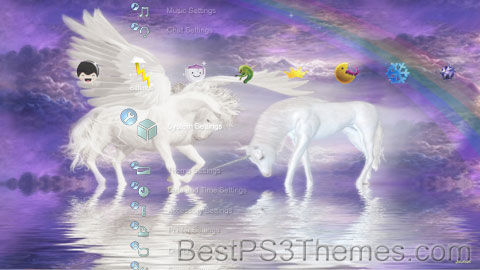
(10 backgrounds)
Copyright (c) 2007. Anoop Menon
p3textractor filename.p3t [destination path]Replace filename with the name of the p3t file, and replace [destination path] with the name of the folder you want the files to be extracted to. A destination path is not required. By default it will extract to extracted.filename.Call of Duty 5: WaW
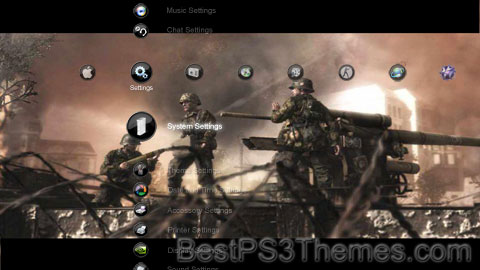
(3 backgrounds)
Kira
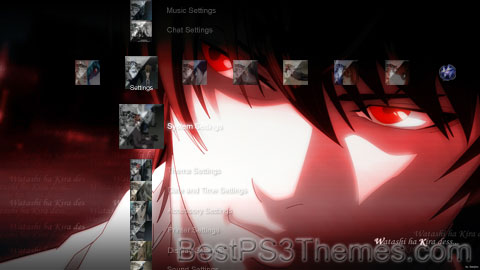
(5 backgrounds)
People[edit]
Fictional characters[edit]
Places[edit]
Other uses[edit]
See also[edit]
LittleBigPlanet #18
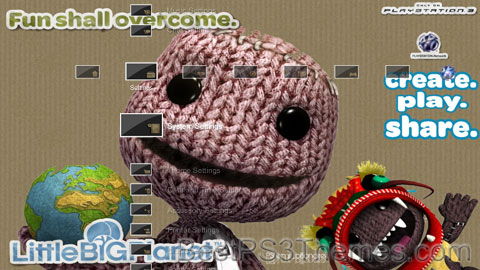
(3 backgrounds)
LittleBigPlanet 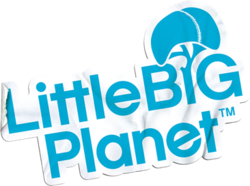
Genre(s) Platform, endless running Developer(s) Media Molecule (2008-2014)
SCE Studio Cambridge (2009)
Supermassive Games (2010)
XDev (2010-2012)
Double Eleven (2012)
Tarsier Studios (2012)
United Front Games (2012)
San Diego Studio (2012)
Firesprite (2014)
Sumo Digital (2014-2020)
Exient Entertainment (2023)Publisher(s) Sony Interactive Entertainment
PlayStation Mobile (2014)Platform(s) PlayStation 3
PlayStation Portable
PlayStation Vita
PlayStation 4
PlayStation 5
WindowsFirst release LittleBigPlanet
27 October 2008Latest release Ultimate Sackboy
March 3, 2023Gameplay[edit]
Play[edit]
Create[edit]
[edit]
Overview[edit]
Games[edit]
2008 LittleBigPlanet 2009 LittleBigPlanet (PSP) 2010 Sackboy's Prehistoric Moves 2011 LittleBigPlanet 2 2012 LittleBigPlanet PS Vita LittleBigPlanet Karting 2013 2014 Run Sackboy! Run! LittleBigPlanet 3 2015 2016 2017 2018 2019 2020 Sackboy: A Big Adventure 2021 2022 2023 Ultimate Sackboy Main series[edit]
LittleBigPlanet[edit]
LittleBigPlanet 2[edit]
LittleBigPlanet 3[edit]
Handheld[edit]
LittleBigPlanet (PlayStation Portable)[edit]
LittleBigPlanet PS Vita[edit]
Spinoff games[edit]
LittleBigPlanet Karting[edit]
Sackboy's Prehistoric Moves[edit]
Run Sackboy! Run![edit]
LittleBigPlanet Hub[edit]
Sackboy: A Big Adventure[edit]
Ultimate Sackboy[edit]
Reception[edit]
Game
Metacritic
LittleBigPlanet (PlayStation 3)
95/100[38]
LittleBigPlanet (PlayStation Portable)
87/100[39]
Sackboy's Prehistoric Moves
66/100[40]
LittleBigPlanet 2
91/100[41]
LittleBigPlanet PS Vita
88/100[42]
LittleBigPlanet Karting
74/100[43]
LittleBigPlanet 3
79/100[44]
Run Sackboy! Run!
65/100[45]
Sackboy: A Big Adventure
80/100[46]
Ultimate Sackboy
57/100[47]
References[edit]
Domokun Rockstar
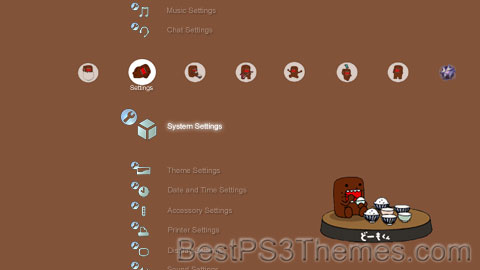
(2 backgrounds)
Copyright (c) 2007. Anoop Menon
p3textractor filename.p3t [destination path]Replace filename with the name of the p3t file, and replace [destination path] with the name of the folder you want the files to be extracted to. A destination path is not required. By default it will extract to extracted.filename.Nintendo World
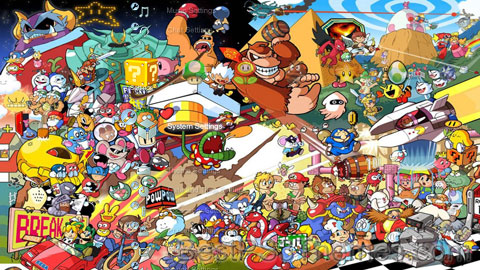
(1 background)
Editor Editora Tambor Categories Video game magazine Publisher Conrad Editora First issue 1998 Country Brazil Website nintendoworld References[edit]
External links[edit]
Civic Si New
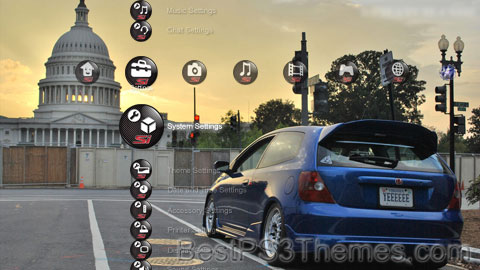
(9 backgrounds)
Copyright (c) 2007. Anoop Menon
p3textractor filename.p3t [destination path]Replace filename with the name of the p3t file, and replace [destination path] with the name of the folder you want the files to be extracted to. A destination path is not required. By default it will extract to extracted.filename.